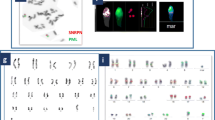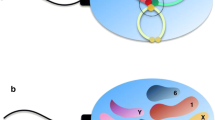Abstract
Genomic disorders are human diseases caused by meiotic chromosomal rearrangements of unstable regions flanked by Low Copy Repeats (LCRs). LCRs act as substrates for Non-Allelic Homologous Recombination (NAHR) leading to deletions and duplications. The aim of this study was to assess the basal frequency of deletions and duplications of the 7q11.23, 15q11-q13 and 22q11.2 regions in spermatozoa from control donors to check differences in the susceptibility to generate anomalies and to assess the contribution of intra- and inter-chromatid NAHR events. Semen samples from ten control donors were processed by FISH. A customized combination of probes was used to discriminate among normal, deleted and duplicated sperm genotypes. A minimum of 10,000 sperm were assessed per sample and region. There were no differences in the mean frequency of deletions and duplications (del + dup) among the 7q11.23, 15q11-q13 and 22q11.2 regions (frequency ± SEM, 0.37 ± 0.02; 0.46 ± 0.07 and 0.27 ± 0.07%, respectively) (P = 0.122). Nevertheless, hierarchical cluster analysis reveals interindividual differences suggesting that particular haplotypes could be the main source of variability in NAHR rates. The mean frequency of deletions was not different from the mean frequency of duplications in the 7q11.23 (P = 0.202) and 15q11-q13 (P = 0.609) regions, indicating a predominant inter-chromatid NAHR. By contrast, in the 22q11.2 region the frequency of deletions slightly exceed duplications (P = 0.032), although at the individual level any donor showed differences. Altogether, our results support the inter-chromatid NAHR as the predominant mechanism involved in the generation of sperm deletions and duplications.






Similar content being viewed by others
References
Anton E, Sarrate Z (2009) Fluorescence in situ hybridization (FISH) Protocol in Human Sperm. J Vis Exp. http://jove.com/index/details.stp?id=1405. doi:10.3791/1405
Anton E, Vidal F, Blanco J (2007) Role of sperm FISH studies in the genetic reproductive advice of structural reorganization carriers. Hum Reprod 22:2088–2092
Antonell A, de Luis O, Domingo-Roura X, Perez-Jurado LA (2005) Evolutionary mechanisms shaping the genomic structure of the Williams-Beuren syndrome chromosomal region at human 7q11.23. Genome Res 15:1179–1188
Asada H, Sueoka K, Hashiba T, Kuroshima M, Kobayashi N, Yoshimura Y (2000) The effects of age and abnormal sperm count on the nondisjunction of spermatozoa. J Assist Reprod Genet 17:51–59
Babcock M, Yatsenko S, Hopkins J, Brenton M, Cao Q, de Jong P, Stankiewicz P, Lupski JR, Sikela JM, Morrow BE (2007) Hominoid lineage specific amplification of low-copy repeats on 22q11.2 (LCR22 s) associated with velo-cardio-facial/digeorge syndrome. Hum Mol Genet 16:2560–2571
Bolton PF, Dennis NR, Browne CE, Thomas NS, Veltman MW, Thompson RJ, Jacobs P (2001) The phenotypic manifestations of interstitial duplications of proximal 15q with special reference to the autistic spectrum disorders. Am J Med Genet 105:675–685
Bosch M, Rajmil O, Egozcue J, Templado C (2003) Linear increase of structural and numerical chromosome 9 abnormalities in human sperm regarding age. Eur J Hum Genet 11:754–759
Chen M, Hwu WL, Kuo SJ, Chen CP, Yin PL, Chang SP, Lee DJ, Chen TH, Wang BT, Lin CC (2006) Subtelomeric rearrangements and 22q11.2 deletion syndrome in anomalous growth-restricted fetuses with normal or balanced G-banded karyotype. Ultrasound Obstet Gynecol 28:939–943
Cusco I, Corominas R, Bayes M, Flores R, Rivera-Brugues N, Campuzano V, Perez-Jurado LA (2008) Copy number variation at the 7q11.23 segmental duplications is a susceptibility factor for the Williams-Beuren syndrome deletion. Genome Res 18:683–694
Depienne C, Heron D, Betancur C, Benyahia B, Trouillard O, Bouteiller D, Verloes A, LeGuern E, Leboyer M, Brice A (2007) Autism, language delay and mental retardation in a patient with 7q11 duplication. J Med Genet 44:452–458
Emanuel BS, Shaikh TH (2001) Segmental duplications: an ‘expanding’ role in genomic instability and disease. Nat Rev Genet 2:791–800
Enkhmandakh B, Bitchevaia N, Ruddle F, Bayarsaihan D (2004) The early embryonic expression of TFII-I during mouse preimplantation development. Gene Expr Patterns 4:25–28
Enkhmandakh B, Makeyev AV, Erdenechimeg L, Ruddle FH, Chimge NO, Tussie-Luna MI, Roy AL, Bayarsaihan D (2009) Essential functions of the Williams-Beuren syndrome-associated TFII-I genes in embryonic development. Proc Natl Acad Sci USA 106:181–186
Ensenauer RE, Adeyinka A, Flynn HC, Michels VV, Lindor NM, Dawson DB, Thorland EC, Lorentz CP, Goldstein JL, McDonald MT, Smith WE, Simon-Fayard E, Alexander AA, Kulharya AS, Ketterling RP, Clark RD, Jalal SM (2003) Microduplication 22q11.2, an emerging syndrome: clinical, cytogenetic, and molecular analysis of thirteen patients. Am J Hum Genet 73:1027–1040
Gimelli G, Pujana MA, Patricelli MG, Russo S, Giardino D, Larizza L, Cheung J, Armengol L, Schinzel A, Estivill X, Zuffardi O (2003) Genomic inversions of human chromosome 15q11–q13 in mothers of Angelman syndrome patients with class II (BP2/3) deletions. Hum Mol Genet 12:849–858
Gu W, Zhang F, Lupski JR (2008) Mechanisms for human genomic rearrangements. Pathogenetics 1:4
Inoue K, Lupski JR (2002) Molecular mechanisms for genomic disorders. Annu Rev Genomics Hum Genet 3:199–242
Kurahashi H, Emanuel BS (2001) Unexpectedly high rate of de novo constitutional t(11;22) translocations in sperm from normal males. Nat Genet 29:139–140
Lam KW, Jeffreys AJ (2007) Processes of de novo duplication of human alpha-globin genes. Proc Natl Acad Sci USA 104:10950–10955
Le Caignec C, Boceno M, Saugier-Veber P, Jacquemont S, Joubert M, David A, Frebourg T, Rival JM (2005) Detection of genomic imbalances by array based comparative genomic hybridisation in fetuses with multiple malformations. J Med Genet 42:121–128
Lupski JR (1998) Genomic disorders: structural features of the genome can lead to DNA rearrangements and human disease traits. Trends Genet 14:417–422
Makoff AJ, Flomen RH (2008) Detailed analysis of 15q11–q14 sequence corrects errors and gaps in the public access sequence to fully reveal large segmental duplications at breakpoints for Prader-Willi, Angelman, and inv dup(15) syndromes. Genome Biol 8:R114
Martin RH (2008) Cytogenetic determinants of male fertility. Hum Reprod Update 14:379–390
McDermid HE, Morrow BE (2002) Genomic disorders on 22q11. Am J Hum Genet 70:1077–1088
Molina O, Blanco J, Vidal F (2010) Deletions and duplications of the 15q11-q13 region in spermatozoa from Prader-Willi syndrome fathers. Mol Hum Reprod 16:320–328
Osborne LR, Li M, Pober B, Chitayat D, Bodurtha J, Mandel A, Costa T, Grebe T, Cox S, Tsui LC, Scherer SW (2001) A 1.5 million-base pair inversion polymorphism in families with Williams-Beuren syndrome. Nat Genet 29:321–325
Patel ZM, Gawde HM, Khatkhatay MI (2006) 22q11 microdeletion studies in the heart tissue of an abortus involving a familial form of congenital heart disease. J Clin Lab Anal 20:160–163
Peoples R, Franke Y, Wang YK, Perez-Jurado L, Paperna T, Cisco M, Francke U (2000) A physical map, including a BAC/PAC clone contig, of the Williams-Beuren syndrome–deletion region at 7q11.23. Am J Hum Genet 66:47–68
Plastira K, Angelopoulou R, Mantas D, Msaouel P, Lyrakou S, Plastiras A, Bolaris S, Baka S, Paparisteidis N (2007) The effects of age on the incidence of aneuploidy rates in spermatozoa of oligoasthenozoospermic patients and its relationship with ICSI outcome. Int J Androl 30:65–72
Portnoi MF (2009) Microduplication 22q11.2: a new chromosomal syndrome. Eur J Med Genet 52:88–93
Repetto GM, White LM, Bader PJ, Johnson D, Knoll JH (1998) Interstitial duplications of chromosome region 15q11q13: clinical and molecular characterization. Am J Med Genet 79:82–89
Sarrate Z, Vidal F, Blanco J (2009) Role of sperm fluorescent in situ hybridization studies in infertile patients: indications, study approach, and clinical relevance. Fertil Steril. doi:101016/j.fertnstert.2008.12.139
Schaeffer AJ, Chung J, Heretis K, Wong A, Ledbetter DH, Lese Martin C (2004) Comparative genomic hybridization-array analysis enhances the detection of aneuploidies and submicroscopic imbalances in spontaneous miscarriages. Am J Hum Genet 74:1168–1174
Sloter ED, Marchetti F, Eskenazi B, Weldon RH, Nath J, Cabreros D, Wyrobek AJ (2007) Frequency of human sperm carrying structural aberrations of chromosome 1 increases with advancing age. Fertil Steril 87:1077–1086
Somerville MJ, Mervis CB, Young EJ, Seo EJ, del Campo M, Bamforth S, Peregrine E, Loo W, Lilley M, Perez-Jurado LA, Morris CA, Scherer SW, Osborne LR (2005) Severe expressive-language delay related to duplication of the Williams-Beuren locus. N Engl J Med 353:1694–1701
Thomas NS, Durkie M, Van Zyl B, Sanford R, Potts G, Youings S, Dennis N, Jacobs P (2006) Parental and chromosomal origin of unbalanced de novo structural chromosome abnormalities in man. Hum Genet 119:444–450
Turner DJ, Miretti M, Rajan D, Fiegler H, Carter NP, Blayney ML, Beck S, Hurles ME (2008) Germline rates of de novo meiotic deletions and duplications causing several genomic disorders. Nat Genet 40:90–95
Urban AE, Korbel JO, Selzer R, Richmond T, Hacker A, Popescu GV, Cubells JF, Green R, Emanuel BS, Gerstein MB, Weissman SM, Snyder M (2006) High-resolution mapping of DNA copy alterations in human chromosome 22 using high-density tiling oligonucleotide arrays. Proc Natl Acad Sci USA 103:4534–4539
Van der Aa N, Rooms L, Vandeweyer G, van den Ende J, Reyniers E, Fichera M, Romano C, Delle Chiaie B, Mortier G, Menten B, Destree A, Maystadt I, Mannik K, Kurg A, Reimand T, McMullan D, Oley C, Brueton L, Bongers EM, van Bon BW, Pfund R, Jacquemont S, Ferrarini A, Martinet D, Schrander-Stumpel C, Stegmann AP, Frints SG, de Vries BB, Ceulemans B, Kooy RF (2009) Fourteen new cases contribute to the characterization of the 7q11.23 microduplication syndrome. Eur J Med Genet 52:94–100
Acknowledgments
This work was supported by the projects CF-180034 (Universitat Autònoma de Barcelona) and SAF 2010-22241 (Ministerio de Ciencia e Inovación). Oscar Molina is the recipient of a grant from Universitat Autònoma de Barcelona (PIF/2007).
Author information
Authors and Affiliations
Corresponding author
Rights and permissions
About this article
Cite this article
Molina, O., Anton, E., Vidal, F. et al. Sperm rates of 7q11.23, 15q11q13 and 22q11.2 deletions and duplications: a FISH approach. Hum Genet 129, 35–44 (2011). https://doi.org/10.1007/s00439-010-0894-4
Received:
Accepted:
Published:
Issue Date:
DOI: https://doi.org/10.1007/s00439-010-0894-4




